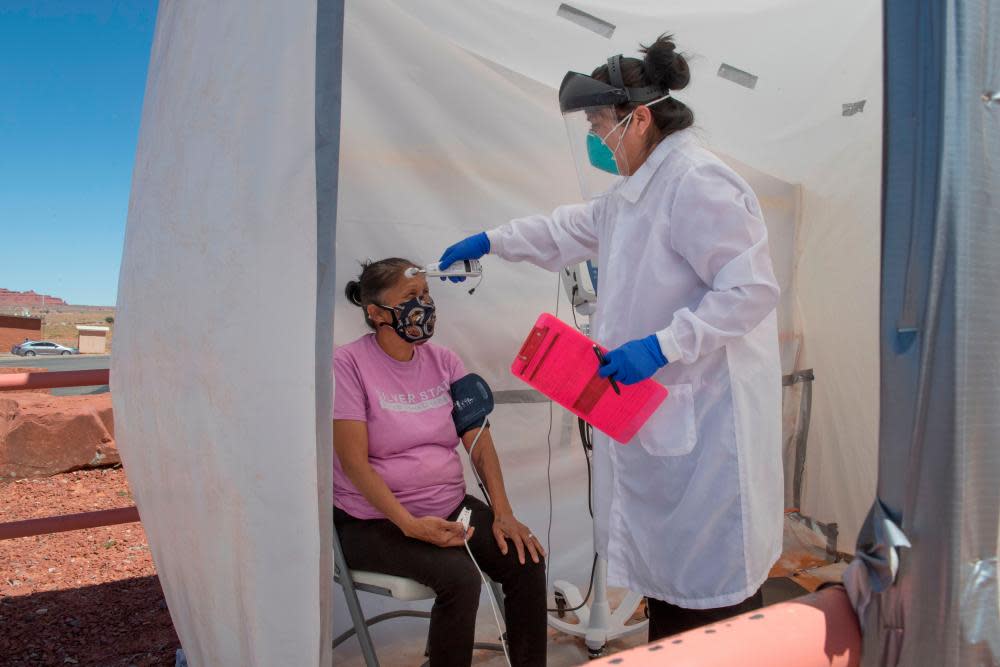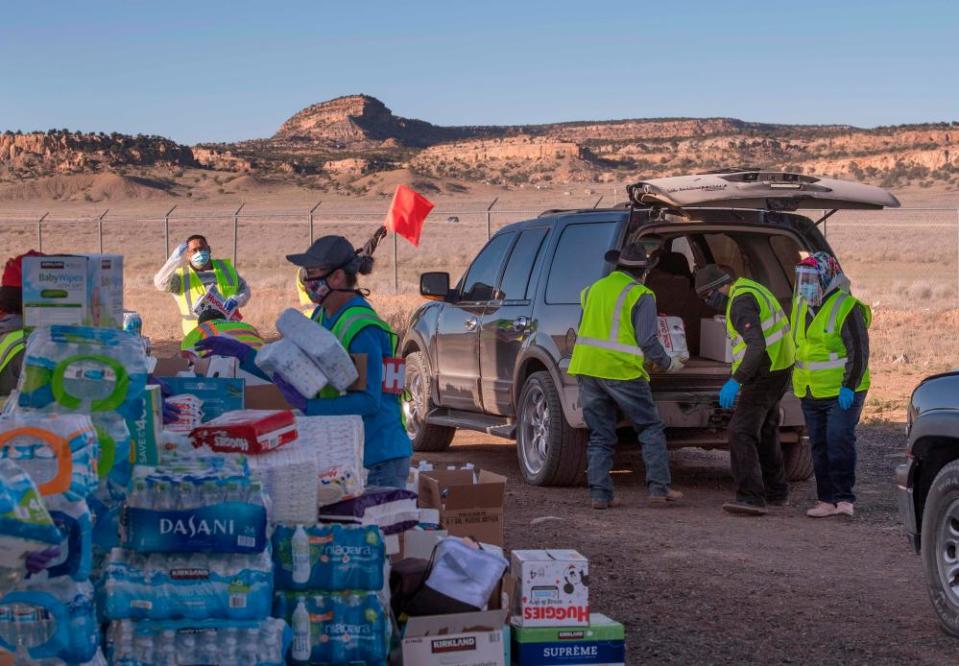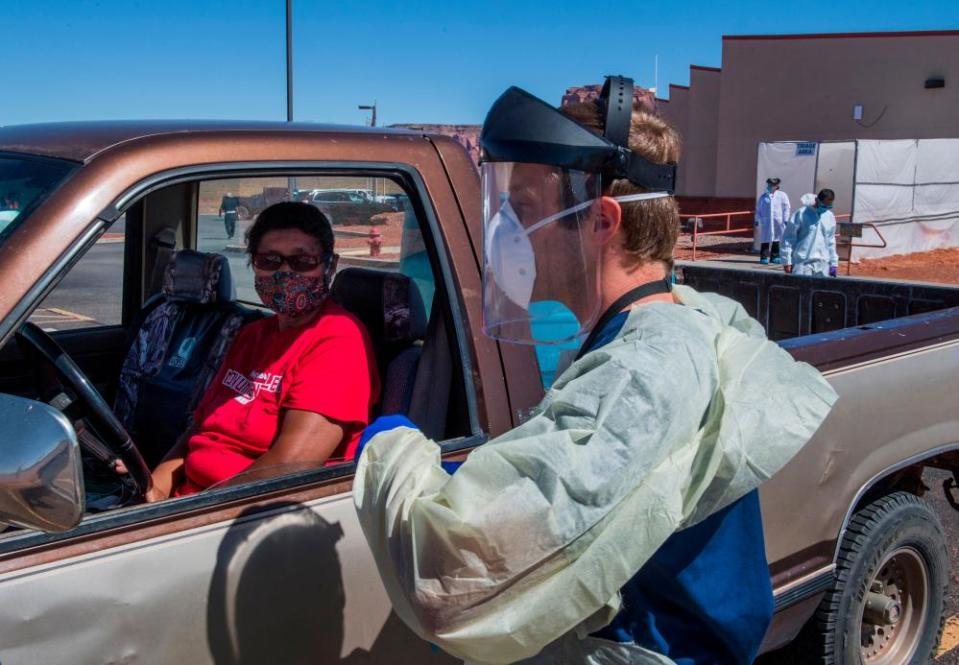Why Native Americans took Covid-19 seriously: 'It's our reality'

In the first few weeks of 2020, as president Donald Trump dismissed and mocked warnings about a novel virus killing people faraway in China, Native American leaders were taking the deadly threat seriously.
And they were right.
The infection rate among the Navajo Nation has now surpassed the state of New York, the centre of the pandemic in the US, and on Monday stood at 2,680 cases per 100,000 people compared with 1,890 in New York.
The data emerging from some smaller tribes is even worse. By mid-May, the known infection rate in the Pueblo of Zia, which has a population of 934 people, was 3,319 per 100,000 – ten times the rate of New Mexico where the tribe is situated, and almost double the rate of New Jersey – the second worst hit US state.
Related: Native Americans being left out of US coronavirus data and labelled as 'other'
The nearby Pueblo of San Felipe, population 3,544, is also badly affected with 3,301 known cases per 100,000. Reporting lags mean the actual infection rate for both tribes could be significantly higher.
Coronavirus is novel to the world, but the impact on native communities is anything but a new experience. Native Americans feared the worst because they’ve been here before many times.
European colonizers introduced, sometimes deliberately, an array of new infectious diseases including measles, cholera, typhoid and smallpox, which for many decades historians believed were solely responsible for killing more than 70% of native people who had no immunity to these deadly foreign germs.
“More than any other population in the country, the shared experience of surviving a pandemic is in our blood, it’s not historic, it’s current for American Indians, it’s our reality. We took it seriously because we had to,” said Desi Rodriguez-Lonebear, a social demographer at the University of Arizona and citizen of the Northern Cheyenne tribe in Montana.

As a child, Rodriguez-Lonebear recalls being told by her grandfather not to play in certain spots where their relatives who died of smallpox and typhoid were buried.
Now, it’s increasingly thought that the cruel conditions of colonization such as forced displacement, enslavement and starvation created the perfect conditions for deadly disease outbreaks, according to Jeffrey Olster, historian at the University of Oregon.
“The impact of Indian removals like the Cherokee trail of tears forced people into horrific conditions of poverty and destitution. It wasn’t just because they weren’t immune, it was the conditions of colonization which made them vulnerable,” said Olster.
This would also explain the lack of population rebound after each epidemic: the same horrific conditions caused low life expectancy and high infant and maternal mortality.
Again, experts say that parallels can be drawn with what’s happening today as the coronavirus pandemic rages across the US.
The disproportionately high Covid-19 infection rates in Indian Country are attributed to chronic structural and economic inequalities such as overcrowded housing, understaffed hospitals, lack of running water and limited internet access – resulting from the US government’s failure to comply with treaty obligations which agreed adequate funding for basic services in exchange for vast amounts of tribal land.
“Back then, like today, tribes are trying to tackle a fatal virus without adequate resources. That’s a strong historic parallel, the simple failure of the federal and state governments to provide the resources necessary,” said Ostler.
In addition, high rates of medical conditions like obesity, diabetes, heart and lung disease have contributed to worse Covid-19 outcomes. For instance in Arizona, the death rate for indigenous people is 42.8 per 100,000 – almost six times higher than for white people. In Mississippi, they are dying from Covid-19 at 10 times the rate of whites, according to analysis published last week by APM Research Lab.
Native communities, who rely on their elders for oral history and traditions, are also concerned about the survival of their ancient cultures.
“We are survivors of genocide, our numbers prove it… for nations with less than a thousand citizens, losing one person is too many,” said Rodriguez-Lonebear. “And losing even one of our elders threatens the future of our tribal nations as it means losing our language, oral histories and the cornerstones of our families and communities.”
In fact, the situation is likely worse as the data currently available is extremely patchy.

In New York, where significant ethnic disparities have emerged, no data is being collected on indigenous peoples. “This oversight is especially hammering… it’s a painful blindspot in New York,” said Andi Egbert, senior demographer at APMResearch.
More than 70% of Native Indians and Alaskan Natives live in urban areas, where many use county and state health services where the data black holes exist.
Native peoples with Covid-19 are being “eliminated from the data” because their ethnicity is so frequently misclassified or ignored, according to Abigail Echo-Hawk, director of the national tribal epidemiology centre based in Seattle.
“Without the data, we’re going to keep dying and nobody is going to acknowledge that… and resources allocated by congress won’t reach the communities,” said Echo-Hawk.
Over recent weeks, Trump and his supporters have pushed for America to reopen for business, even though scientists are still months from finding a vaccine or treatment.
Yet native communities have demonstrated a greater historical awareness of the experience of pandemics, and tried to protect their citizens through measured emergency responses with limited resources, but which assert their right to self determination and governance.
In South Dakota, tribes set-up roadblocks to protect their citizens after the pro-Trump governor refused to issue a stay at home order. In Washington, the Lummi Nation created the country’s first field hospital, while the Navajo Nation, the second largest tribe in the US, has tested over 13% of those on the reservation compared to 4% in the US.
“Indigenous nations have been through so many waves of pandemics and epidemics that they have a well of resilience, stamina and intergenerational knowledge that others just do not have,” said Jessica Kolopenuk, a political theorist and indigenous studies scholar at the University of Alberta. “I am of the strong opinion that indigenous knowledge and world views can really help change the course of this pandemic.”


